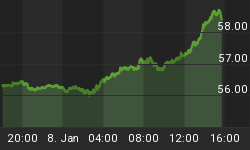The following is part of Pivotal Events that was published for our subscribers Thursday, August 28, 2008.
SIGNS OF THE TIMES:
Last Year:
"We are experiencing a global bull market of Titanic proportions. The central banks of the world now have the ability and the power to create fiat money at will."
- Richard Russell, August 30, 2007
"Art Loans Get Hung Up By Default Concerns"
- Wall Street Journal, September 1, 2007
And not a moment too soon we would think.
This Year:
For some each day seems to be arriving at a moment too soon.
"Where Did Wall Street Go Wrong"
This headlined the New York Times August 7, 2008 story on a 172 page report on the credit contraction. We haven't had time to review the study, but it would be a safe bet that it didn't mention the change in the yield curve in May 2007.
"Virtually everybody was slow in recognizing that we were on the cusp of a really draconian crisis."
- Gerald Corrigan, a former president of the N. Y. Fed, who chaired the study.
"Apartment Buildings Lose Their Immunity to Housing's Chill"
"Rent Rates Decline"
- Wall Street Journal. August 20, 2008
* * * * *
Stock Markets: Last week we reviewed the "Roadmap" that brought us into probable choppy action through August. This we have and our ideal would be a rally going into early September.
The latter seems to be prompted by an absence of banking disasters, the rebound in some commodities and a pause in the dollar's advance. Clearly, these are relief responses to intense pressures and if the past continues to guide the sunshine could prevail into next week, at least.
As we noted last week, changes in the curve and spreads have extended their trends towards dislocating conditions likely to be "discovered" in October. In so many words, credit conditions are such that the equity markets will be vulnerable to the next "discovery" of a banking disaster, or to the next decline in industrial commodities and rally in the dollar index.
The "models" we have been using called for the sharp break in the third week of May that would lead to an initial decline of around 25% from the October high. This worked out, as did the sharp rebound and the choppy August. Ultimately, the loss could amount to around 48% and it is uncertain if this could be accomplished in the pending melancholy season or later.
Later seems likely, as most bears worthy of the name run for around 18 months. This October marks 12 months since the high and too many strategists still claim that each calamity is a buying opportunity. At the end of a massive bear market there are no bulls - not even theoretical ones.
The upshot is more down and when the time arrives the ChartWorks Downside Capitulation model will likely register the condition of opportunity. If memory serves (Ross is on vacation), the post-1929 and post-2000 bears required 3 such washouts before markets were finally cleared of unsupportable baggage.
However this may be, our favourite model has been the 1873 Bubble that included the Treasury System that with a brilliant secretary and fiat currency was proof against any sort of contraction. Now central banks with fiat currencies are still considered as a preventative of a severe contraction. As the saying goes - so far so bad.
The next decline could take down most, if not all, equity sectors.
Gold Sector:
News Item:
"Pawnbrokers Grab The Gold Ring"
"Business is booming at pawnbrokers as the effect of the credit crunch forces a small but growing number of consumers to sell their gold."
This is a Wall Street Journal (UK) story dated today and seems to be in line with gold's experience in September of 1929 and 1873.
Senior golds fell with the hit to industrial commodities. For numbers, the HUI slumped from 479 on July 14 to the 310 level in mid August. The rebound has carried to 355 today and the sector is vulnerable to the pending liquidity crisis.
We have been looking to reposition later in October.
Other than something to trade, the gold/silver ratio is an indicator of boom or bust. For us, rising through 54 would suggest market forces were turning again to credit contraction and price deflation of most of the hot games.
This occurred with the hit to metal and energy prices and the ratio made it to 62. This has set the up trend and in previous phases of financial distress silver has done some serious declines relative to gold. This could happen by late September.
Once again it is time to use any strength in the silver stocks to get short.
Link to August 29, 2008 'Bob and Phil Show' on Howestreet.com: http://www.howestreet.com/index.php?pl=/goldradio/index.php/mediaplayer/946
















